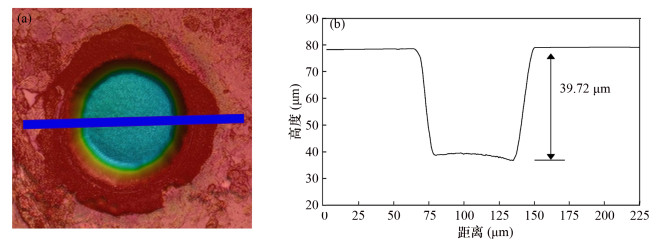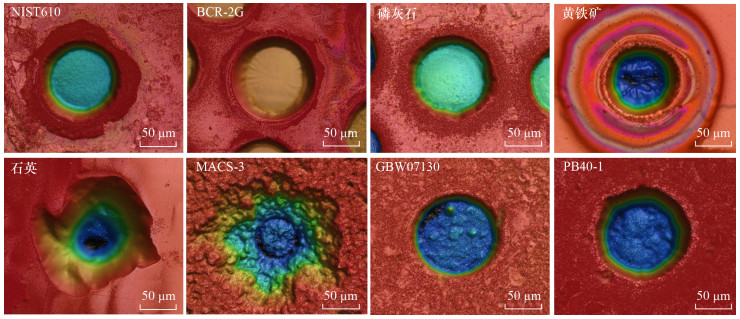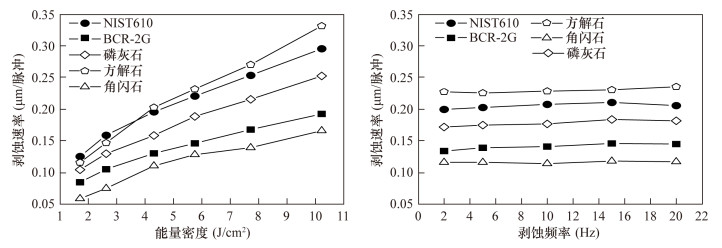Study on Ablation Behaviors and Ablation Rates of a 193nm ArF Excimer Laser System for Selected Substrates in LA-ICP-MS Analysis
-
摘要: 探究LA-ICP-MS分析中不同基体的剥蚀行为和剥蚀速率,可为激光参数设定、基体匹配选择、数据质量保证等方面提供重要参考。本文研究了193 nm ArF准分子激光系统对人工合成/地质样品玻璃、常见矿物和粉末压片的剥蚀行为,同时探究了激光参数(束斑直径、能量密度和剥蚀频率)对剥蚀速率的影响情况。从剥蚀坑形貌可知,193nm ArF激光对玻璃和绝大多数矿物的剥蚀行为良好,但对石英相对较差,这可能与石英内含有微观包裹体,剥蚀过程中局部受热不均有关。粉末压片的剥蚀行为呈现出不可控,可通过提高粉末压片的压制压力或降低粉末颗粒的粒径来改善剥蚀行为;当剥蚀深度大于1.5倍束斑直径时,剥蚀速率随剥蚀深度的增加而逐渐减小,剥蚀深度最多可达束斑直径的两倍左右(RESOlution M-50型号激光系统,3.0 J/cm2激光能量密度);剥蚀速率随激光能量密度的增加而增大,但基本不受剥蚀频率(2~20 Hz)影响。不同基体具有特征的剥蚀速率,本文报道了43种基体的剥蚀速率参数,总体而言,NIST系列玻璃的剥蚀速率大于地质样品玻璃,碳酸盐矿物和硫化物矿物大于硅酸岩矿物,粉末压片大于玻璃和常见矿物。
-
关键词:
- LA-ICP-MS /
- 193nm ArF激光 /
- 剥蚀行为 /
- 剥蚀速率 /
- 能量密度
Abstract: Understanding laser ablation behaviors of different target materials is essential for optimum laser parameters, external reference materials selection, as well as for data quality assurance. In this study, ablation behaviors of a 193nm ArF excimer laser for silicate glasses, common minerals, and powder pellets were investigated. Ablation rates influenced by laser parameters (including spot size, energy density, and laser frequency) were evaluated. Topographic images of craters generated during ablation illustrate that glasses and most minerals have controllable ablation behaviors, except for quartz. The worse ablation behavior of quartz may be ascribed to the micro-fluid inclusions, which could result in the overheating effect in laser pits. In general, powder pellets have worse ablation behaviors, but the increase of tableting pressure or reducing the particle grain size could improve the ablation behaviors. Ablation rates gradually decrease if the ablation depth is larger than 1.5 times of the spot size. The maximum ablation depth can reach twice the spot size when the energy density is 3.0 J/cm2 for the RESOlution M-50 laser system). Ablation rates increase with the increase of laser energy density, but ablation rates are not affected by the laser frequency (2-20 Hz). Ablation rates are specific to the individual substrates. In conclusion, the ablation rate data of 43 substrates, in which ablation rates of powder pellets are larger than glasses and minerals, whereas those of carbonates and sulfides are larger than silicate minerals, and those of NIST glasses are larger than geological glasses.
-
Keywords:
- LA-ICP-MS /
- 193nm ArF excimer laser /
- ablation behavior /
- ablation rate /
- energy density
-
锰矿是工业产业重要的基础性大宗原料矿产,中国的电解锰产量占了全世界的95%。锰还是钢最基本的元素,是对钢及其钢材性能产生重要影响的合金化元素,所有钢种及其钢材都含锰。锰多以化合物形式广泛分布于自然界,几乎各种矿石及硅酸盐的岩石中均含有锰矿。近年来我国对锰矿消费需求量大,且我国锰矿又多是贫、杂、含磷量偏高的低品位矿,作为最大的锰系铁合金生产国,我国的锰矿资源已经远远不能满足需求,与国内的贫锰矿搭配使用[1]。2011年全国各口岸进口锰矿石约1350万吨,仅天津口岸进口批次达到1500余批,主要进口国为南非、澳大利亚、加蓬、巴西、加纳五国。近年来,进口贸易商不断拓展海外市场,缅甸、印度尼西亚、印度、菲律宾、纳米比亚、摩洛哥等非主要锰矿生产国的矿石也大量进口至国内,其锰含量水平差异较大,杂质元素水平较为复杂。面对检验批次的大幅度增加,矿产品检验检疫行业迫切需要开展多批次自动化检测锰矿石中锰含量的实施方案,以降低劳动强度,提高锰矿石中锰分析的准确度和精密度。
目前锰矿石中锰含量的测定方法包括X射线荧光光谱法[2]、手工电位滴定法[3]、手工目视滴定法[3]等。X射线荧光光谱法分析锰含量时由于锰矿的高湿存水,熔制玻璃片时要求操作者具备很高的经验,否则很容易产生气泡,而且需要配备多个水平的标准样品,另外检测成本较高。手工电位滴定法操作手续繁杂,无法移植到自动电位滴定仪上。手工目视滴定法相对于其他方法溶样较为简单,滴定方法适合移植到自动电位滴定仪。本文建立了锰含量的自动电位滴定法,对自动电位滴定仪滴定锰含量的电位变化特点进行深入分析,确定了滴定参数,优化滴定速度,对标定空白和样品空白溶液测定给出了测定方法,实现手工滴定向自动电位滴定的转变。
1. 自动电位滴定法的实现
现有文献[3-4]有两种手工滴定方法可供选择:高锰酸钾电位滴定法和目视滴定法。
KMnO4电位滴定法的反应方程式为:

该法滴定时需要分取样品溶液至盛有焦硫酸钠的溶液中且需要不断搅拌,当出现沉淀时需要增加焦硫酸钠溶液,以保证溶液清亮。还需调节试液pH值,再用KMnO4标准溶液进行电位滴定。故该法向自动电位滴定法移植时有困难。
目视滴定法反应方程式为:

采用该法将样品分解,Mn氧化成+3价后,滴定步骤可在自动电位滴定仪上直接完成,采用氧化还原电极判断终点,不用指示剂,从而避免了指示剂的干扰[5],无需调节酸度等操作,能够适应不同锰含量范围的样品。因此,选择手工目视滴定法向自动电位滴定法进行移植更为简便。
2. 实验部分
2.1 仪器
809型自动电位滴定仪(瑞士Metrohm公司),配3个滴定单元;自动滴定单元为50 mL;10322840型铂复合电极(瑞士Metrohm公司);814型自动样品转换器(瑞士Metrohm公司)。
2.2 主要试剂
重铬酸钾标准溶液

硫酸亚铁铵标准溶液 c[(NH4)2Fe(SO4)2·6H2O]≈0.040 mol/L:称取15.68 g硫酸亚铁铵[(NH4)2Fe(SO4)2·6H2O](天津市天大化工实验厂产品),溶于1000 mL的5%硫酸中。
硫磷混合酸:400 mL硫酸(20%)和50 mL磷酸按比例混匀。
盐酸、硝酸、硫酸、磷酸、高氯酸。除特别注明外试剂均为分析纯,水为新鲜去离子水。
2.3 实验方法
准确称取0.2 g空气平衡试样,加5 mL盐酸和20 mL磷酸,在约200℃的电热板上加热分解10 min后取下,加 3~5 mL硝酸,继续加热至微冒磷酸烟,取下稍冷,加2 mL高氯酸在约250℃下加热至液面平静,使二价锰氧化完全,即刻取下,防止焦磷酸盐析出。冷却至约70℃后加50 mL水,充分摇动溶解,流水冷却至室温。转移至自动电位滴定仪上的150 mL专用滴定杯中,调整溶液体积约80 mL。同时称取试料测定湿存水[6]。
3. 结果与讨论
3.1 滴定参数的确定
无论是用硫酸亚铁铵滴定标定空白中的重铬酸钾还是测试试样滴定三价锰,都是从高电位向低电位滴定,其滴定拐点很“陡”,先兆不明显,在临近终点前0.20 mL都不会出现较大的电位下降,但终点突跃明显,突跃电位差达300 mV,发生在600~900 mV之间,发生突跃的体积范围在0.30 mL左右。仪器提供了“优化”、“快”、“慢”三种可选滴定参数模式,通过控制仪器滴定参数发现,三种模式均得不到理想的滴定曲线,也就找不到理想的等当点,如图 1所示。经过调试,先将信号漂移值适当调小,以增加预判能力。由于滴定时溶液电位稳定时间较快,故可将滴定参数中“最小等待时间”和“最大等待时间”缩短,可提高滴定速度,并且使滴定曲线满意。
本文确定了适合锰矿石标定和滴定精度要求的滴定参数,表 1列出了标定及空白滴定重铬酸钾的滴定参数、滴定试样中三价锰的滴定参数。按照本参数滴定等当点理想,如图 2所示。
表 1 动态滴定参数Table 1. Parameters of dynamic titration滴定参数 标定/空白 试样滴定 信号漂移(mV/min) 15 40 最小等待时间(s) 2 1 最大等待时间(s) 3 3 测量点密度 4 4 最小加液量(μL) 10 10 最大加液量(μL) 50 100 加液速度(mL/min) 10 最大 3.2 自动电位滴定程序的设计
3.2.1 硫酸亚铁铵标准溶液的标定
编写程序,用自动电位滴定仪准确加入25.00 mL重铬酸钾标准溶液,加入45 mL硫磷混合酸,利用自动电位滴定仪的加水功能,将溶液体积调整为约80 mL,使电极浸没在溶液中。用硫酸亚铁铵标准溶液滴定。经过测算消耗滴定溶液体积约为25 mL。为缩短滴定时间,先预加24.00 mL硫酸亚铁铵标准溶液,再滴定至终点。计算浓度时,将标定体积扣除标定空白后得到净体积。程序自动计算出浓度,将标液浓度值写入芯片供滴定样品时调用计算。
3.2.2 试样溶液的滴定和滴定速度的优化
由于进口锰矿石锰含量水平为5%~60%,范围很宽,如果采用同一滴定步骤,对于水平较高的样品,滴定时间冗长。经过对滴定曲线的分析,滴定初始电位在1000 mV以上,终点出现在500~1000 mV之间,故将1000 mV设定为滴定先兆。先用“电位滴定”模式,快速加入硫酸亚铁铵标准溶液至溶液电位到达1000 mV左右,再采用“等当点滴定模式”滴定至终点,显著提高了滴定速度。
首先采用等当点滴定方式,起始电位一般在1000 mV以上,进行快速预滴定,停止等当点设为1000 mV,当电位达到1000 mV时,预滴定结束,此时可发现样品溶液所呈紫色明显变浅,显示已临近终点[7-9]。等当点滴定结束后再进行动态滴定,参数见表 2,总滴定时间可在5 min内完成,滴定曲线满意。
表 2 等当点滴定参数Table 2. The parameters of equivalent point titration滴定过程 工作参数 设定值 预滴定 停止电位 1000 mV 滴定速度 动态范围 100 mV 最大加液速度 35 mL/min 最小加液速度 200 μL/min 停止标准 等待 2 s 3.2.3 空白的滴定
由于氧化还原滴定中试剂不可避免会引入试剂空白,故需要编写程序滴定空白用于样品的扣除。空白的引入包括硫酸亚铁铵标准溶液标定部分(称之为标定空白)和试样滴定部分(称之为样品空白)。由于试剂引入的空白可能是还原性物质,也可能是氧化性物质,故空白值可正可负。先用自动电位滴定仪准确加入10.00 mL重铬酸钾标准溶液(测试标定空白时还需加入45 mL硫磷混合酸),仪器补充水至滴定体积为80 mL。先预加9.00 mL硫酸亚铁铵标准溶液滴定,滴定至终点。然后,再次准确加入10.00 mL重铬酸钾标准溶液,预加9.00 mL硫酸亚铁铵标准溶液滴定,再滴定至终点。在计算空白值时,由于自动电位滴定仪利用ΔE/ΔV曲线获得等当点时,必须滴过等当点,故在计算空白值时,利用三个参数计算后得出,包括:第一次滴定的等当点体积(VEp1)、第一次滴定结束后的体积(VEVT)、第二次滴定等当点体积(VEp2)。空白值(V0)按下式计算。

3.2.4 滴定终点的识别
自动电位滴定仪默认终点判别为大于“等当点识别标准”值,即ΔE/ΔV值高于预设值为找到滴定终点[10-11]。为使本方法稳健,屏蔽样品滴定过程中的各种伪终点。经过多次测试,确定了终点参数,设定列于表 3。
表 3 空白和试样等当点识别参数Table 3. Parameters of the equivalent point in blank and sample工作参数 空白/标定 试样滴定 停止体积(mL) 20 60 停止测量值(mV) 450 450 到达等当点后加的体积(mL) 0.5 1 停止时间 关 关 吸液速度 最大值 最大值 带测量值的窗口评估下限(mV) 600 600 带测量值的窗口评估上限(mV) 900 900 等当点识别标准 50 70 3.3 方法准确度和精密度
用本方法对6种不同水平锰矿石国家一级标准物质进行6次重复性分析,结果列于表 4。测定平均值与标准值的相对偏差(RE) < 0.2%,相对标准偏差(RSD) < 0.3(n=6),方法准确度和精密度较好,优于标准[3-4]对精密度的要求,能够满足分析要求。
表 4 准确度及精密度试验Table 4. Accuracy and precision tests of method标准物质
编号w(Mn)/% 相对偏差
RE/%RSD/% 标准值 测定平均值 GBW 07261 45.39 45.44 0.11 0.16 GBW 07262 36.99 37.00 0.03 0.16 GBW 07263 32.54 32.60 0.18 0.14 GBW 07264 25.00 25.03 0.12 0.16 GBW 07265 22.54 22.50 -0.18 0.22 GBW 07266 15.74 15.74 0.00 0.27 3.4 常见离子干扰
高氯酸作为强氧化剂,可将Cr(Ⅲ)、Ce(Ⅲ)、V(Ⅲ)氧化至高价,形成干扰。通常贸易中的锰矿石这三个元素含量甚微,不予考虑。
3.5 方法对照
对天津口岸近年来进口国的不同水平锰矿石样品采用手工目视滴定法[3]和本法测定锰的含量,结果见表 5。对表 5数据进行t检验,得t=0.87,小于临界值2.26,故认为两种方法无显著性差异。相对而言,自动电位滴定方法稳健。
表 5 分析结果比对Table 5. Comparison of analytical results of elements in samples样品来源 w(Mn)/% 目视
滴定法本法
测定值阿曼 19.04 19.01 印度 24.66 24.67 马来西亚 32.96 32.96 澳大利亚 32.98 33.07 南非 36.96 36.87 南非 37.05 37.09 加蓬 43.27 43.21 澳大利亚 50.22 50.29 加蓬 50.30 50.28 巴西 50.81 50.77 4. 结语
随着工业技术的不断进步,商业化自动电位滴定仪正逐渐朝着智能化方向发展,对于普通的滴定操作者只需按照默认滴定参数即可得到理想的等当点。对于较为特殊的滴定反应,需要操作者熟知滴定原理及仪器控制参数,设计出合适的滴定方法和控制参数。本文将影响自动电位滴定结果的三个关键环节:滴定参数的建立、等当点识别标准的设定和滴定计算程序的设计进行了深入讨论,建立了一套实际应用方案。特别是在滴定分析锰矿石样品时,由于进口锰矿石水平为5%~60%,范围跨度大,在滴定程序设计时必须对终点先兆进行判别,从而提高滴定速度。
本研究方法自动便捷、操作简单,缩短了测量周期,较其他方法有较高精密度和准确度,适宜大批量检测,减少人工操作,有较强的实用性,适合在出入境检验检疫行业锰矿石冶炼企业推广,也为建立其他相关矿产品分析方法提供了参考。
致谢: 感谢德国哥廷根大学Andreas Kronz博士、Burkhard Schmidt博士、Istvan Dunkl博士和Smruti Sourav Rout博士研究生,德国汉诺威大学张超博士,国家地质实验测试中心詹秀春研究员,中国科学技术大学刘海洋博士研究生,中国地质大学(武汉)田欢博士研究生,以及成都理工大学曾令旗博士研究生等提供的样品。 -
图 2 NIST610、BCR-2G、磷灰石、黄铁矿、石英、MACS-3、GBW01730和PB40-1的剥蚀坑三维形貌图(激光能量密度为5.0 J/cm2,束斑直径为75 μm)
Figure 2. 3D topographic images of laser generated craters of NIST610, BCR-2G, apatite, pyrite, quartz, MACS-3, GBW01730 and PB40-1.Laser ablation conditions are that energy density is 5.0 J/cm2 and spot size is 75 μm
图 4 剥蚀速率随激光能量密度和剥蚀频率的变化情况。能量密度实验是在设定激光频率5 Hz、束斑直径75 μm、剥蚀时间20 s等固定参数下,通过改变能量密度来进行;剥蚀频率实验是在设定能量密度为4.2 J/cm2、束斑直径75 μm、150激光脉冲等固定参数下,通过改变剥蚀频率来进行
Figure 4. The variations of ablation rate with respect to energy density and laser frequency. For the energy density experiment, the laser parameters are given as laser frequency (5 Hz), spot size (75 μm), and ablation time (20 s). For the laser frequency experiment, the laser parameters are given as energy density (4.2 J/cm2), spot size (75μm), and laser pulses (150)
图 5 43种基体的激光剥蚀速率。激光能量为2.0 J/cm2(石英除外,为5.0 J/cm2),每个点重复三次以上,图中的误差棒为深度测量的一倍标准偏差
Figure 5. The ablation rates of 43 sample matrix. The data are collected in the laser conditions: the energy density of 2.0 J/cm2 (expected quartz, 5.0 J/cm2). Every analysis has 3 repeats and error bars are derived from 3 analyses as 1 time standard deviation
表 1 LA-ICP-MS仪器工作参数
Table 1 Operation conditions of LA-ICP-MS system
激光剥蚀系统 电感耦合等离子体质谱 激光类型 RESOlution M-50 ArF准分子 ICP-MS Element 2 波长 193 nm RF功率 1500 W 脉冲时间 20 ns 屏蔽圈(Pt) 悬浮 能量密度 1.0~11.0 J/cm2 冷却气(Ar)流量 15.00 L/min 激光频率 2~20 Hz 辅助气(Ar)流量 1.00 L/min 剥蚀池 Laurin Technic S-155 载气(Ar)流量 0.95 L/min 激光束斑直径 10~90 μm 停留时间 10 ms 剥蚀气(He)流量 0.65 L/min 检测器 计数与模拟 剥蚀时间 20~120 s 分辨率 低(~300) -
Liu Y S, Hu Z C, Li M, et al.Applications of LA-ICP-MS in the elemental analyses of geological samples[J].Chinese Science Bulletin, 2013, 58(32):3863-3878. doi: 10.1007/s11434-013-5901-4
Russo R E, Mao X, Gonzalez J J, et al.Laser ablation in analytical chemistry[J].Analytical Chemistry, 2013, 85(13):6162-6177. doi: 10.1021/ac4005327
Li Z, Hu Z, Günther D, et al.Ablation characteristics of ilmenite using UV nanosecond and femtosecond lasers:Implications for non-matrix-matched quantification[J].Geostandards and Geoanalytical Research, 2016, 40(4):477-491. doi: 10.1111/ggr.2016.40.issue-4
Flem B, Larsen R B, Grimstvedt A, et al.In situ analysis of trace elements in quartz by using laser ablation inductively coupled plasma mass spectrometry[J].Chemical Geology, 2002, 182(2-4):237-247. doi: 10.1016/S0009-2541(01)00292-3
Stead C V, Tomlinson E L, Kamber B S, et al.Rare earth element determination in olivine by laser ablation-quadrupole-ICP-MS:An analytical strategy and applications[J].Geostandards and Geoanalytical Research, 2017:DOI: 10.1111/ggr.12157.
Chew D M, Donelick R A, Donelick M B, et al.Apatite chlorine concentration measurements by LA-ICP-MS[J].Geostandards and Geoanalytical Research, 2014, 38(1):23-35. doi: 10.1111/j.1751-908X.2013.00246.x
Yuan H L, Gao S, Liu X M, et al.Accurate U-Pb age and trace element determinations of zircon by laser ablation-inductively coupled plasma-mass spectrometry[J].Geostandards and Geoanalytical Research, 2004, 28(3):353-370. doi: 10.1111/ggr.2004.28.issue-3
Li C Y, Zhang R Q, Ding X, et al.Dating cassiterite using laser ablation ICP-MS[J].Ore Geology Reviews, 2016, 72:313-322. doi: 10.1016/j.oregeorev.2015.07.016
Yang Y H, Wu F Y, Li Y, et al.In situ U-Pb dating of bastnaesite by LA-ICP-MS[J].Journal of Analytical Atomic Spectrometry, 2014, 29(6):1017-1023. doi: 10.1039/C4JA00001C
Zack T, Stockli D F, Luvizotto G L, et al.In situ U-Pb rutile dating by LA-ICP-MS:208Pb correction and pros-pects for geological applications[J].Contributions to Mineralogy and Petrology, 2011, 162(3):515-530. doi: 10.1007/s00410-011-0609-4
Cruz-Uribe A M, Mertz-Kraus R, Zack T, et al.A new LA-ICP-MS method for Ti in quartz:Implications and application to high pressure rutile-quartz veins from the Czech Erzgebirge[J].Geostandards and Geoanalytical Research, 2016, 41(1):29-40. doi: 10.1111/ggr.12132/full
Audétat A, Garbe-Schönberg D, Kronz A, et al.Charac-terisation of a natural quartz crystal as a reference material for microanalytical determination of Ti, Al, Li, Fe, Mn, Ga and Ge[J].Geostandards and Geoanalytical Research, 2015, 39(2):171-184. doi: 10.1111/ggr.2015.39.issue-2
He Z, Huang F, Yu H, et al.A flux-free fusion tech-nique for rapid determination of major and trace elements in silicate rocks by LA-ICP-MS[J].Geostandards and Geoanalytical Research, 2016, 40(1):5-21. doi: 10.1111/ggr.2016.40.issue-1
Peters D, Pettke T.Evaluation of major to ultra trace element bulk rock chemical analysis of nanoparticulate pressed powder pellets by LA-ICP-MS[J].Geostandards and Geoanalytical Research, 2017, 41(1):5-28. doi: 10.1111/ggr.12125
Tang M, Arevalo Jr R, Goreva Y, et al.Elemental frac-tionation during condensation of plasma plumes generated by laser ablation:A ToF-SIMS study of condensate blankets[J].Journal of Analytical Atomic Spectrometry, 2015, 30(11):2316-2322. doi: 10.1039/C5JA00320B
吴石头, 王亚平, 詹秀春, 等.CGSG系列标准物质元素分馏效应及主量微量元素单元内均匀性探究[J].岩矿测试, 2016, 35(6):612-620. doi: 10.15898/j.cnki.11-2131/td.2016.06.007 Wu S T, Wang Y P, Zhan X C, et al.Study on the elemental fractionation effect of CGSG reference materials and the related within-unit homogeneity of major and trace elements[J].Rock and Mineral Analysis, 2016, 35(6):612-620. doi: 10.15898/j.cnki.11-2131/td.2016.06.007
Hu Z C, Liu Y S, Chen L, et al.Contrasting matrix ind-uced elemental fractionation in NIST SRM and rock glasses during laser ablation ICP-MS analysis at high spatial resolution[J].Journal of Analytical Atomic Spectrometry, 2011, 26(2):425-430. doi: 10.1039/C0JA00145G
Jochum K P, Stoll B, Weis U, et al.Non-matrix-matched calibration for the multi-element analysis of geological and environmental samples using 200nm femtosecond LA-ICP-MS:A comparison with nanosecond lasers[J].Geostandards and Geoanalytical Research, 2014, 38(3):265-292. doi: 10.1111/ggr.2014.38.issue-3
Sylvester P J.Matrix effects in laser ablation ICP-MS.Laser ablation ICP-MS in the earth sciences:Current practices and outstanding issues (Sylvester P, ed.)[J].Mineralogical Association of Canada, 2008, 40:67-78. http://www.worldcat.org/title/laser-ablation-icp-ms-in-the-earth-sciences-current-practices-and-outstanding-issues/oclc/253374987
Liu Y S, Hu Z C, Gao S, et al.In situ analysis of major and trace elements of anhydrous minerals by LA-ICP-MS without applying an internal standard[J].Chemical Geology, 2008, 257(1-2):34-43. doi: 10.1016/j.chemgeo.2008.08.004
Jackson S E.Calibration strategies for elemental analysis by LA-ICP-MS.Laser ablation ICP-MS in the earth sciences:Current practices and outstanding issues (Sylvester P, ed.)[J].Mineralogical Association of Canada, 2008, 40:169-188. doi: 10.1080/00032719.2016.1225305
Paton C, Woodhead J D, Hellstrom J C, et al.Improved laser ablation U-Pb zircon geochronology through robust downhole fractionation correction[J].Geochemistry, Geophysics, Geosystems, 2010, 11(3):1-36. doi: 10.1029/2009GC002618/abstract?globalMessage=0
吴石头, 王亚平, 许春雪.激光剥蚀电感耦合等离子体质谱元素微区分析标准物质研究进展[J].岩矿测试, 2015, 34(5):503-511. doi: 10.15898/j.cnki.11-2131/td.2015.05.002 Wu S T, Wang Y P, Xu C X.Research progress on reference mterials for in situ elemental analysis by laser ablation-inductive coupled plasma-mass spectrometry[J].Rock and Mineral Analysis, 2015, 34(5):503-511. doi: 10.15898/j.cnki.11-2131/td.2015.05.002
Yang Q C, Jochum K P, Stoll B, et al.BAM-S005 type A and B:New silicate reference glasses for microanalysis[J].Geostandards and Geoanalytical Research, 2012, 36(3):301-313. doi: 10.1111/ggr.2012.36.issue-3
Jochum K P, Wilson S A, Becker H, et al.FeMnOx-1:A new microanalytical reference material for the investigation of Mn-Fe rich geological samples[J].Chemical Geology, 2016, 432:34-40. doi: 10.1016/j.chemgeo.2016.03.026
Tabersky D, Luechinger N A, Rossier M, et al.Develop-ment and characterization of custom-engineered and compacted nanoparticles as calibration materials for quantification using LA-ICP-MS[J].Journal of Analytical Atomic Spectrometry, 2014, 29(6):955-962. doi: 10.1039/C4JA00054D
Klemme S, Prowatke S, Münker C, et al.Synthesis and preliminary characterisation of new silicate, phosphate and titanite reference glasses[J].Geostandards and Geoanalytical Research, 2008, 32(1):39-54. doi: 10.1111/j.1751-908X.2008.00873.x
Horn I, Guillong M, Günther D.Wavelength dependant ablation rates for metals and silicate glasses using homogenized laser beam profiles-Implications for LA-ICP-MS[J].Applied Surface Science, 2001, 182(1-2):91-102. doi: 10.1016/S0169-4332(01)00465-2
Borisov O V, Mao X, Russo R E.Effects of crater develop-ment on fractionation and signal intensity during laser ablation inductively coupled plasma mass spectrometry[J].Spectrochimica Acta Part B:Atomic Spectroscopy, 2000, 55(11):1693-1704. doi: 10.1016/S0584-8547(00)00272-X
Mank A J G, Mason P R D.A critical assessment of laser ablation ICP-MS as an analytical tool for depth analysis in silica-based glass samples[J].Journal of Analytical Atomic Spectrometry, 1999, 14(8):1143-1153. doi: 10.1039/a903304a
Li X, Liu X, Liu Y, et al.Accuracy of LA-ICPMS zircon U-Pb age determination:An inter-laboratory comparison[J].Science China Earth Sciences, 2015, 58(10):1722-1730. doi: 10.1007/s11430-015-5110-x
Horstwood M S, Košler J, Gehrels G, et al.Community-derived standards for LA-ICP-MS U-(Th-) Pb geochro-nology-uncertainty propagation, age interpretation and data reporting[J].Geostandards and Geoanalytical Research, 2016, 40(3):311-332. doi: 10.1111/ggr.2016.40.issue-3
吴石头, 王亚平, 许春雪, 等.193nm ArF准分子激光剥蚀系统高空间分辨率下元素分馏研究[J].分析化学, 2016, 44(7):1035-1041. doi: 10.11895/j.issn.0253-3820.151006 Wu S T, Wang Y P, Xu C X, et al.Elemental fractionation studies of 193nm ArF excimer laser ablation system at high spatial resolution mode[J].Chinese Journal of Analytical Chemistry, 2016, 44(7):1035-1041. doi: 10.11895/j.issn.0253-3820.151006
Günther D, Heinrich C A.Comparison of the ablation behaviour of 266nm Nd:YAG and 193nm ArF excimer lasers for LA-ICP-MS analysis[J].Journal of Analytical Atomic Spectrometry, 1999, 14(9):1369-1374. doi: 10.1039/A901649J
Jeffries T E, Jackson S E, Longerich H P.Application of a frequency quintupled Nd:YAG source (λ=213nm) for laser ablation inductively coupled plasma mass spectrometric analysis of minerals[J].Journal of Analytical Atomic Spectrometry, 1998, 13(9):935-940. doi: 10.1039/A801328D
Kuhn B K, Birbaum K, Luo Y, et al.Fundamental studies on the ablation behaviour of Pb/U in NIST 610 and zircon 91500 using laser ablation inductively coupled plasma mass spectrometry with respect to geochronology[J].Journal of Analytical Atomic Spectrometry, 2010, 25(1):21-27. doi: 10.1039/B917261K
Garbe-Schonberg D, Müller S.Nano-particulate pressed powder tablets for LA-ICP-MS[J].Journal of Analytical Atomic Spectrometry, 2014, 29(6):990-1000. doi: 10.1039/C4JA00007B
Zhang C, Hu Z, Zhang W, et al.A green and fast laser fusion technique for bulk silicate rock analysis by laser ablation ICP-MS[J].Analytical Chemistry, 2016, 88(20):10088-10094. doi: 10.1021/acs.analchem.6b02471
Ubide T, McKenna C A, Chew D M, et al.High-resolution LA-ICP-MS trace element mapping of igneous minerals:In search of magma histories[J].Chemical Geology, 2015, 409:157-168. doi: 10.1016/j.chemgeo.2015.05.020
Raimondo T, Payne J, Wade B, et al.Trace element mapping by LA-ICP-MS:Assessing geochemical mobility in garnet[J].Contributions to Mineralogy and Petrology, 2017, 172(4):17. doi: 10.1007/s00410-017-1339-z
Bi M, Ruiz A M, Gornushkin I, et al.Profiling of patterned metal layers by laser ablation inductively coupled plasma mass spectrometry (LA-ICP-MS)[J].Applied Surface Science, 2000, 158(3-4):197-204. doi: 10.1016/S0169-4332(00)00027-1
Müller W, Shelley M, Miller P, et al.Initial performance metrics of a new custom-designed ArF excimer LA-ICPMS system coupled to a two-volume laser-ablation cell[J].Journal of Analytical Atomic Spectrometry, 2009, 24(2):209-214. doi: 10.1039/B805995K
Steely A N, Hourigan J K, Juel E.Discrete multi-pulse laser ablation depth profiling with a single-collector ICP-MS:Sub-micron U-Pb geochronology of zircon and the effect of radiation damage on depth-dependent fractionation[J].Chemical Geology, 2014, 372:92-108. doi: 10.1016/j.chemgeo.2014.02.021
Jackson S E, Günther D.The nature and sources of laser induced isotopic fractionation in laser ablation-multicollector-inductively coupled plasma-mass spectrometry[J].Journal of Analytical Atomic Spectrometry, 2003, 18(3):205-212. doi: 10.1039/b209620j
Gaboardi M, Humayun M.Elemental fractionation during LA-ICP-MS analysis of silicate glasses:Implications for matrix-independent standardization[J].Journal of Analytical Atomic Spectrometry, 2009, 24(9):1188-1197. doi: 10.1039/b900876d
Mao X L, Russo R E.Invited paper observation of plasma shielding by measuring transmitted and reflected laser pulse temporal profiles[J].Applied Physics A:Materials Science & Processing, 1996, 64(1):1-6. doi: 10.1007/s003390050437
Russo R E, Mao X L, Liu C, et al.Laser assisted plasma spectrochemistry:Laser ablation[J].Journal of Analytical Atomic Spectrometry, 2004, 19(9):1084-1089. doi: 10.1039/b403368j



 下载:
下载:







 京公网安备 11010202008159号
京公网安备 11010202008159号